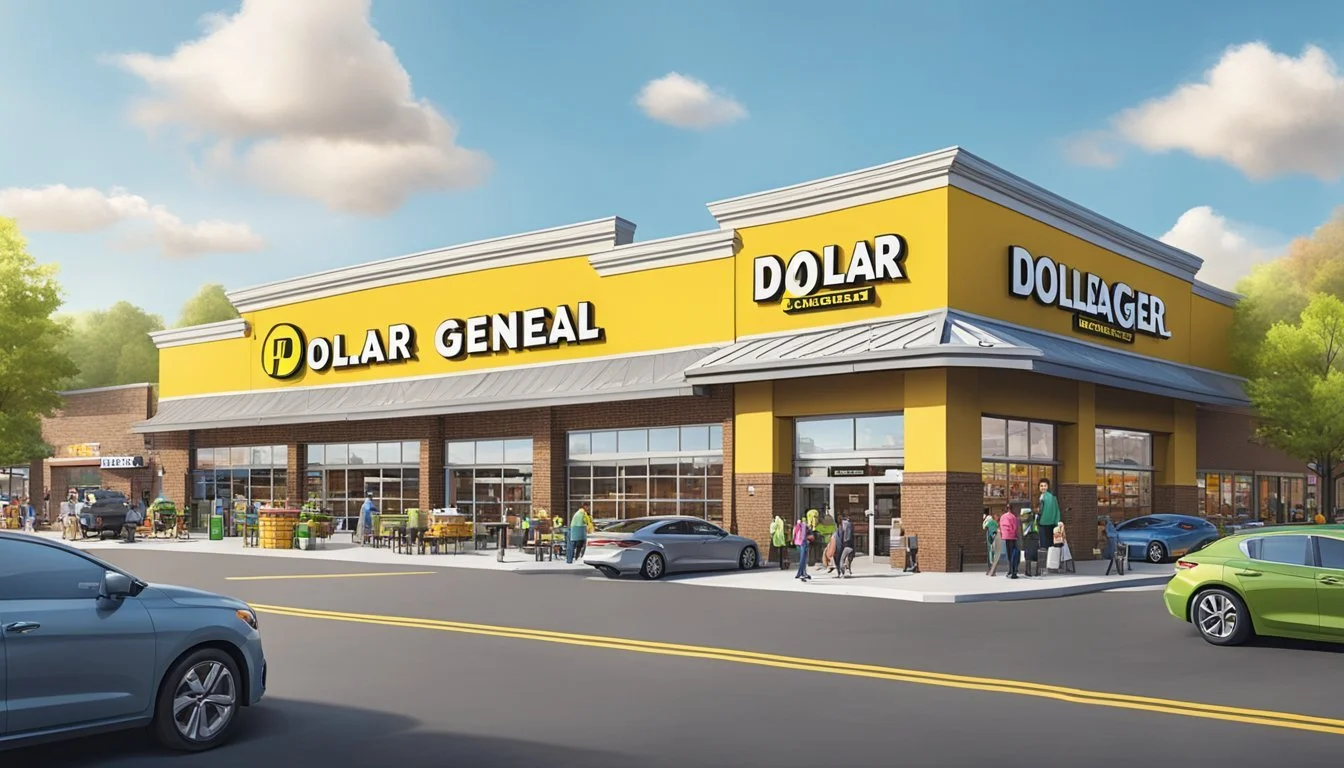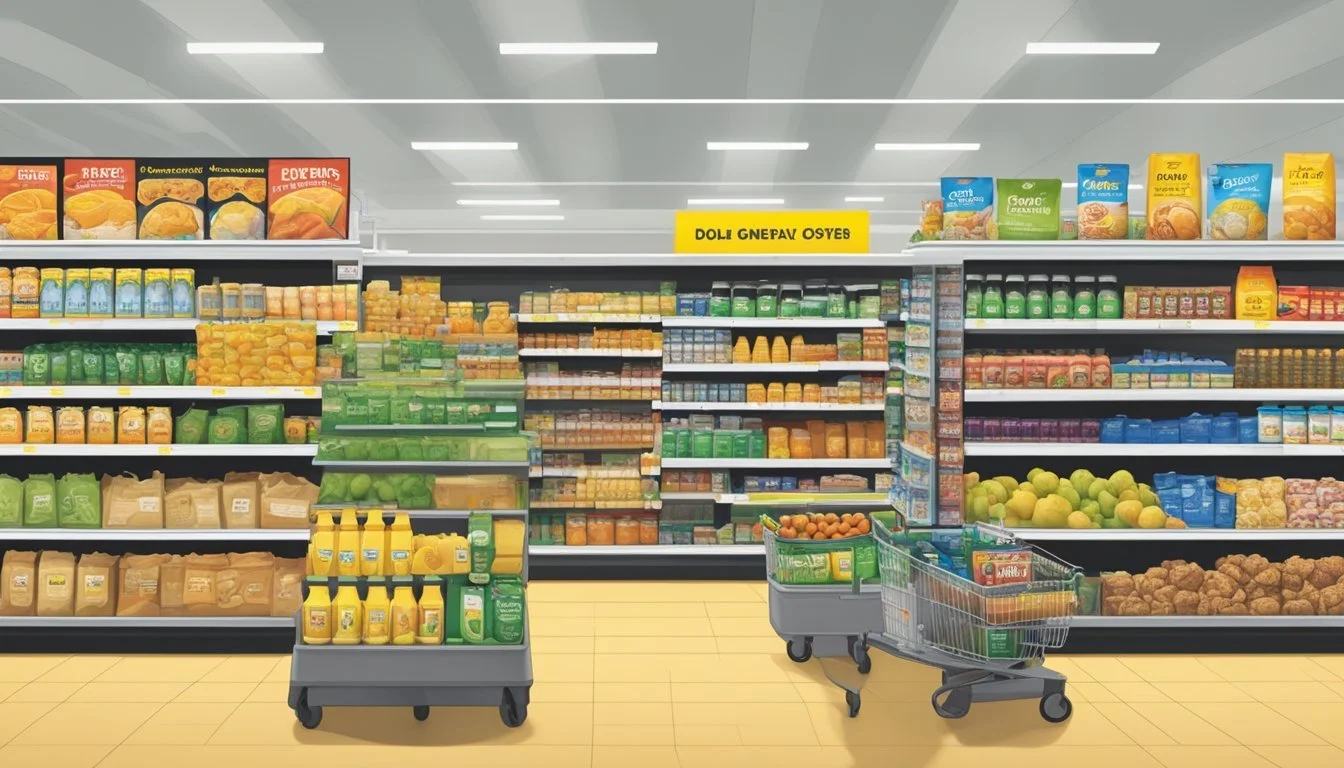Dollar General vs Hannaford
Comparing Prices, Selection, and Quality
Dollar General and Hannaford represent two distinct approaches to grocery shopping in the United States. While Dollar General focuses on offering low-priced items across various categories, Hannaford positions itself as a traditional supermarket with a wider range of products and services.
For overall value and selection, Hannaford typically provides a better grocery shopping experience than Dollar General. Hannaford offers fresher produce, higher-quality meats, and a more extensive selection of brand-name and organic products. The chain also tends to have cleaner stores and superior customer service.
Dollar General has its advantages, particularly for budget-conscious shoppers looking for quick, convenient purchases of household essentials and non-perishable goods. The chain's smaller store formats and widespread locations make it accessible in many rural and urban areas. Ultimately, the choice between Dollar General and Hannaford depends on individual shopping needs, budget constraints, and location preferences.
Overview of Dollar General and Hannaford
Dollar General and Hannaford represent two distinct segments of the grocery retail market. These companies differ significantly in their business models, store formats, and target demographics.
Company Histories and Market Position
Dollar General began in 1939 as a wholesale business and evolved into a discount retailer. It has grown to become one of the largest discount chains in the United States, with over 18,000 stores across 47 states.
Hannaford's roots trace back to 1883 when it started as a produce store in Portland, Maine. Today, it operates as a regional supermarket chain with approximately 180 stores in five northeastern states.
Dollar General focuses on offering everyday essentials at low prices, while Hannaford positions itself as a full-service grocery store with a wider range of products and fresh offerings.
Store Formats and Branding
Dollar General stores are typically smaller, ranging from 7,000 to 10,000 square feet. They carry a limited selection of groceries, household items, and personal care products. The company has also introduced new formats like DGX for urban areas and pOpshelf for suburban shoppers.
Hannaford stores are larger supermarkets, usually 20,000 to 50,000 square feet. They offer a full range of groceries, including fresh produce, meat, seafood, and bakery items. Hannaford emphasizes its commitment to quality and community engagement in its branding.
Target Demographics and Geographic Reach
Dollar General primarily targets low to middle-income consumers in rural and suburban areas. Its strategy involves placing stores in locations often overlooked by larger retailers, making it a convenient option for many shoppers in small towns and communities.
Hannaford caters to a broader demographic, serving customers across various income levels. Its stores are concentrated in the northeastern United States, particularly in Maine, New Hampshire, Vermont, Massachusetts, and New York.
Dollar General's widespread presence in rural areas has made it a crucial source for basic groceries and household items in many communities with limited shopping options. Hannaford, with its regional focus, has built strong local connections and tailored its offerings to meet the preferences of northeastern consumers.
Price Comparison and Value for Money
Dollar General and Hannaford employ different strategies to attract budget-conscious shoppers. Their pricing models and product offerings cater to distinct consumer segments seeking value for their grocery dollars.
Price Points and Discount Strategies
Dollar General focuses on everyday low prices across a limited selection of items. Many products are priced at $1 or less, appealing to shoppers on tight budgets. The store offers frequent promotions and digital coupons to drive additional savings.
Hannaford, in contrast, provides a wider range of products at competitive prices. They run weekly sales and offer a loyalty program for extra discounts. Hannaford's pricing is generally higher than Dollar General's, but they often have better deals on fresh produce and meats.
Both stores use private label brands to offer lower-priced alternatives to national brands. Dollar General's house brands are typically the cheapest option, while Hannaford's store brands balance quality and affordability.
Quality vs. Cost: Consumer Perceptions
Shoppers often perceive Dollar General as the go-to for rock-bottom prices, particularly on packaged goods and household items. The trade-off is a limited selection and potentially lower quality on some products.
Hannaford is generally viewed as offering better quality, especially in fresh departments. Many consumers feel the slightly higher prices at Hannaford are justified by superior produce, meats, and bakery items.
For pantry staples and non-perishables, Dollar General often beats Hannaford on price. However, Hannaford's broader selection and fresher offerings may provide better overall value for families seeking a one-stop shopping experience.
Consumer perception of value varies based on individual priorities. Those focused solely on price may prefer Dollar General, while shoppers willing to pay a bit more for quality and variety often choose Hannaford.
Product Selection and Availability
Dollar General and Hannaford offer distinct product selections to cater to different shopper needs. Their inventory management and fresh food offerings also vary significantly.
Variety and Exclusivity of Merchandise
Dollar General focuses on providing everyday essentials at low prices. Their shelves stock a mix of name-brand and private-label items across categories like cleaning supplies, personal care, and pantry staples.
Hannaford, as a full-service supermarket, carries a broader range of products. They offer an extensive selection of groceries, including specialty and gourmet items. Hannaford's private brand provides quality alternatives to national brands.
Dollar General's limited space means a curated selection, while Hannaford's larger footprint allows for more variety in each category.
Stock and Inventory Management
Dollar General employs a lean inventory model, focusing on fast-moving items. This approach can sometimes lead to out-of-stock situations for popular products. Their restocking cycle may be less frequent than traditional supermarkets.
Hannaford maintains a more comprehensive inventory system. They typically have higher stock levels and reorder more frequently. This results in better product availability and fewer empty shelves.
Both stores use data-driven systems to predict demand and manage stock levels, but Hannaford's larger scale often translates to more consistent availability.
Comparing Freshness: Produce and Meat
Dollar General's fresh food offerings are limited. Some locations carry a small selection of fruits and vegetables, but the focus is on shelf-stable and frozen items. Fresh meat is not typically available at Dollar General stores.
Hannaford excels in fresh produce and meat departments. They offer a wide variety of fruits and vegetables, often sourced locally when in season. Their meat department includes various cuts and types, including organic and grass-fed options.
Hannaford's commitment to freshness extends to their seafood and dairy sections, providing a one-stop shop for fresh groceries. Dollar General, while convenient for basic needs, cannot match Hannaford's fresh food selection.
Shopping Experience and Convenience
Dollar General and Hannaford offer distinct shopping experiences, with varying store layouts and technological integrations. Both aim to provide convenience, but their approaches differ in key ways.
Store Layout and Navigability
Dollar General stores typically feature a compact layout with clearly marked aisles. Products are often stacked on shelves and in rolltainers, maximizing space in smaller locations. This setup allows for quick shopping trips but can feel cramped during busy times.
Hannaford supermarkets boast wider aisles and a more spacious layout. Their stores are organized into distinct departments, making it easier to navigate for larger grocery trips. Fresh produce and prepared foods sections are prominently displayed, catering to health-conscious shoppers.
Dollar General's layout emphasizes efficiency, while Hannaford focuses on a more relaxed shopping experience. This difference reflects their target markets and store concepts.
Self-Checkout and Technology Integration
Dollar General has been expanding its self-checkout options in many locations. These kiosks help reduce wait times and offer a quick exit for customers with just a few items. The company has also introduced a mobile app for digital coupons and easy shopping list creation.
Hannaford invests heavily in technology to enhance convenience. Their stores feature multiple self-checkout kiosks, often with attendants nearby to assist. The supermarket chain also offers a robust online ordering system with curbside pickup options, integrating digital convenience with their physical stores.
Both retailers recognize the importance of technology in modern grocery shopping. However, Hannaford's larger stores and broader product range allow for more extensive tech integration.
Access to Nutritious and Fresh Food
Dollar General and Hannaford have different approaches to providing nutritious and fresh food options. Their strategies impact food deserts and insecurity in unique ways, with both stores expanding their fresh food selections.
Impact on Food Deserts and Insecurity
Dollar General has made strides in addressing food deserts by introducing fresh produce to over 5,400 stores. This expansion brings fruits and vegetables to areas with limited access to nutritious foods.
The company's efforts aim to combat food insecurity, especially in rural and underserved communities. Dollar General's DG Better For You program offers recipes and in-store information to help customers make healthier choices.
Hannaford, as a traditional grocery chain, typically operates larger stores with more extensive fresh food departments. This format provides a wider variety of nutritious options but may be less accessible in some areas.
Expansion of Fresh Food Options
Dollar General's fresh produce sections span 16 feet of wall space, offering items like onions, apples, lemons, and organic salad kits. The company also stocks milk, eggs, bread, cheese, and frozen vegetables in most locations.
Hannaford stores feature larger produce departments with a broader selection of fresh fruits and vegetables. They typically carry a wide range of items including bananas, avocados, tomatoes, and carrots.
Both retailers have expanded their fresh food offerings during the pandemic, recognizing increased demand for healthy options. Dollar General's focus on smaller formats allows for quicker expansion into underserved areas.
Hannaford's traditional grocery model provides more comprehensive fresh food selections but requires larger store footprints. This can limit their ability to reach some food desert areas quickly.
Health and Nutrition Focus
Dollar General and Hannaford take different approaches to providing nutritious options for their customers. Their strategies impact the availability and affordability of healthy foods.
Balanced Offerings of Packaged vs. Whole Foods
Dollar General emphasizes shelf-stable packaged foods, offering a limited selection of fresh produce. Their canned vegetables and fruits provide affordable nutrition, though some contain added sugar or sodium. Frozen produce like mixed berries and broccoli is available at competitive prices.
Hannaford stocks a wider variety of fresh fruits, vegetables, and lean proteins. Their produce section features organic and conventional options. Hannaford's packaged foods include healthier alternatives with lower sodium and sugar content.
Both stores carry whole grain products and cereals. Dollar General's options tend to be more limited but budget-friendly. Hannaford offers a broader range of whole grain breads, pastas, and cereals, including specialty diet items.
Hannaford provides more resources for healthy living, such as nutritional information and recipe ideas. Dollar General focuses on convenience and value, with fewer health-oriented services.
Brand Presence and Marketing
Dollar General and Hannaford employ distinct strategies to establish their brand identities and connect with customers. Their approaches to advertising, public image, and digital engagement reflect their unique market positions and target audiences.
Advertising Campaigns and Public Image
Dollar General focuses on value-driven messaging, emphasizing affordability and convenience. Their ads often highlight everyday low prices and the wide variety of products available. The company's yellow and black color scheme is instantly recognizable, reinforcing brand recall. Dollar General's public image centers on being a neighborhood store that serves communities across America.
Hannaford takes a different approach, positioning itself as a purveyor of fresh, high-quality groceries. Their campaigns often showcase local produce and emphasize healthy living. Hannaford's green branding evokes freshness and sustainability. The chain has built a reputation for community involvement and supporting local farmers, which strengthens its public image as a responsible corporate citizen.
Digital Footprint and Social Media Strategies
Dollar General maintains an active online presence with a user-friendly website and mobile app. Their digital platforms offer digital coupons, weekly ads, and a store locator. On social media, Dollar General shares budget-friendly tips, product highlights, and promotional offers. They engage customers through contests and user-generated content campaigns.
Hannaford's digital strategy focuses on providing nutritional information and recipes on their website. Their social media accounts feature cooking tips, healthy eating advice, and spotlights on local suppliers. Hannaford leverages these platforms to promote their commitment to sustainability and community initiatives. The company also uses targeted email marketing to share personalized offers with loyalty program members.
Economic Impact and Corporate Practices
Dollar General and Hannaford have distinct approaches to their economic impact and corporate practices. These differences affect job creation, local economies, sustainability efforts, and corporate responsibility initiatives.
Job Creation and Local Economies
Dollar General operates over 18,000 stores across the United States, primarily in rural and suburban areas. The company employs approximately 170,000 people, offering entry-level positions and opportunities for advancement. However, its business model often leads to lower wages and fewer full-time positions compared to traditional grocery stores.
Hannaford, with around 180 stores in the Northeast, employs about 26,000 people. The company tends to offer more full-time positions and higher wages. Hannaford's stores are typically larger and require more staff, potentially creating a more significant economic impact in local communities.
Dollar General's rapid expansion has faced criticism for potentially harming local businesses and reducing overall employment in some areas. Hannaford, as a regional chain, often integrates more closely with local economies and suppliers.
Corporate Responsibility and Sustainability
Dollar General's sustainability efforts focus on energy efficiency in stores and distribution centers. The company has implemented LED lighting and more efficient HVAC systems. Their community initiatives include literacy programs and disaster relief efforts.
Hannaford has made substantial commitments to sustainability. All Hannaford stores are Platinum LEED certified, demonstrating leadership in energy and environmental design. The company has achieved zero food waste-to-landfill status and emphasizes locally sourced products.
Both companies have food donation programs, but Hannaford's efforts are more extensive. Hannaford also prioritizes sustainable seafood practices and works with local farmers to support regional agriculture.
Comparative Analysis of Customer Service
Dollar General and Hannaford take different approaches to customer service. Their strategies impact the shopping experience in unique ways, from staff interactions to complaint handling.
Staff Interaction and Assistance
Dollar General typically operates with a lean staff model. Employees often handle multiple tasks, which can limit their availability for customer assistance. Shoppers may need to be more self-reliant when locating items or seeking product information. The store layout is generally straightforward, making it easier for customers to navigate independently.
Hannaford, as a full-service grocery store, usually maintains a higher staff-to-customer ratio. Employees are often more readily available to assist shoppers. Many Hannaford stores have designated service counters for specific departments like deli, bakery, and meat, providing specialized assistance.
Resolution of Customer Complaints
Dollar General's complaint resolution process is designed for efficiency. The company offers a toll-free customer service number and an online contact form. Store managers have some autonomy in addressing issues on-site, which can lead to quicker resolutions for simple problems.
Hannaford tends to have a more comprehensive approach to complaint handling. They offer multiple channels for customers to voice concerns, including in-store service desks, phone support, and social media. Hannaford's customer service representatives often have more flexibility in offering solutions, such as refunds or replacements, without requiring manager approval for most issues.
Loyalty Programs and Customer Retention
Loyalty programs play a crucial role in shaping customer relationships at Dollar General and Hannaford. These initiatives offer unique benefits and rewards to incentivize repeat purchases and foster brand loyalty.
Membership Benefits and Rewards
Dollar General's DG Digital Coupons program allows customers to load digital coupons onto their accounts for instant savings at checkout. The program offers personalized deals based on shopping history, helping customers save on frequently purchased items.
Hannaford's My Hannaford Rewards provides a 2% reward on over 5,200 store-brand products. This includes both fresh and center-store items, giving shoppers a wide range of options to earn rewards. The program stands out for its simplicity, as customers don't need to subscribe to receive price discounts.
Both programs aim to drive customer retention through different approaches. Dollar General focuses on immediate savings, while Hannaford emphasizes rewards on store-brand purchases. These strategies cater to different customer preferences, potentially influencing shopping decisions and store loyalty.












